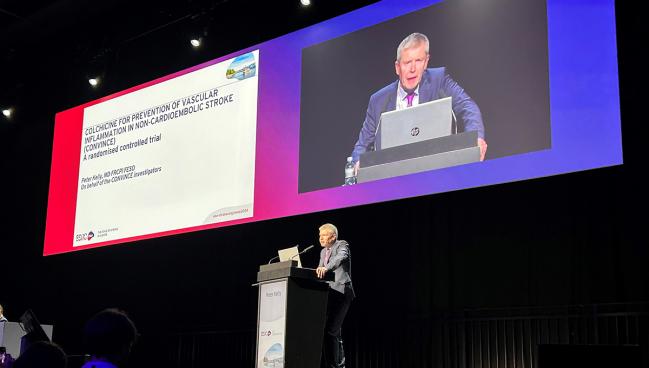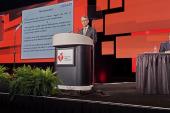Colchicine Misses in Secondary Stroke Prevention, but Door Not Closed Yet
The concept is bolstered when the results are pooled with coronary studies, but “we need more trials,” a researcher says.

BASEL, Switzerland—Low-dose colchicine doesn’t significantly reduce MACE in patients who have had a nonsevere ischemic stroke or high-risk TIA, according to the results of the CONVINCE trial.
Through a median follow-up of nearly 3 years, the rate of ischemic stroke, MI, cardiac arrest, hospitalization for unstable angina, or vascular death was 9.8% when colchicine was added to usual care and 11.8% when patients were treated with usual care alone, a difference that fell shy of statistical significance (HR 0.84; 95% CI 0.68-1.05), Peter Kelly, MD (Mater University Hospital/University College Dublin, Ireland), reported here at the European Stroke Organisation Conference (ESOC) 2024.
But, he noted, the trial—which will be published soon in the Lancet—was slightly underpowered due both to the impact of the COVID-19 pandemic and to an early stoppage for budget reasons, which led to 8% fewer outcomes than initially anticipated.
When the CONVINCE results were pooled with those from several trials of colchicine in patients with coronary disease, there was a significantly lower risk of ischemic stroke in patients treated with the anti-inflammatory agent. While the totality of evidence suggests there might be a role for the drug, Kelly, who is president of the ESO, said “we need more trials.”
The CONVINCE Trial
Colchicine is an anti-inflammatory agent that has been shown to reduce cardiovascular events in patients who have or who are at risk of developing atherosclerotic CVD. The rationale for studying it in secondary stroke prevention comes from prior research demonstrating that inflammation plays a role in the pathogenesis of both first and recurrent strokes caused by large-artery atherosclerosis, small-vessel disease, and unidentified etiology (ie, cryptogenic).
In CONVINCE, the investigators tested whether colchicine would provide vascular protection in patients who had had a nonsevere ischemic stroke or high-risk TIA. Patients were included if the treating clinician determined—after initial clinical investigations—that their event was related to large-artery atherosclerosis or small-vessel disease, or was cryptogenic; those with evidence of atrial fibrillation, cardioembolism, or other defined causes like dissection were excluded.
The main analysis included 3,144 patients (mean age 66; 30% women), most of whom (88%) had a stroke as their qualifying event. Median NIHSS score at randomization was 1.
Randomization occurred 72 hours to 28 days after the qualifying event, with patients assigned to low-dose colchicine (0.5 mg daily) plus guideline-based usual care or usual care alone. At the beginning of the study, nearly all patients were being treated with antiplatelet therapy (97%) and statins (94%).
During a median follow-up of 34 months, there were 244 ischemic strokes and 94 coronary events contributing to the primary MACE endpoint, with no significant difference between the colchicine and control groups. Results were similar when excluding hospitalization for unstable angina from the endpoint and when analyzing the impact on ischemic stroke alone (HR 0.80; 95% CI 0.62-1.03).
A prespecified on-treatment analysis indicated a significant reduction in MACE with colchicine (HR 0.80; 95% CI 0.63-0.99), although Kelly cautioned that any secondary analyses should be considered hypothesis-generating since there was no significant difference between groups on the primary endpoint.
Subgroup analyses consistently demonstrated point estimates that leaned toward a benefit of colchicine, although the differences were not statistically significant. Patients with known coronary disease at randomization appeared to derive the greatest benefits.
C-reactive protein levels were significantly lower at each time point with the drug than with usual care alone. That provides, Kelly said, “objective data supporting a biological effect of colchicine.”
In addition, the drug was safe, with no increases in death or serious adverse events, Kelly reported. There were higher rates of diarrhea (12.1%) and nausea (3.4%) in the colchicine arm, but, he said, these usually resolved quickly by reducing the dose or stopping the drug. Of note, about one-fifth of colchicine-treated patients permanently discontinued therapy during follow-up.
Totality of the Evidence
Although any potential benefits observed in CONVINCE should be interpreted cautiously in the context of the neutral primary endpoint, additional evidence from prior trials of colchicine in patients with coronary disease provide some support for its use in secondary stroke prevention. In a meta-analysis of CONVINCE and four prior colchicine trials—with CONVINCE providing 80% of the weight—use of the drug was associated with a significantly lower risk of ischemic stroke (RR 0.73; 95% CI 0.58-0.90).
Commenting on CONVINCE for TCTMD, Seemant Chaturvedi, MD (University of Maryland School of Medicine, Baltimore), said “it requires some nuanced interpretation.” The on-treatment analysis, which addressed the relatively high rate of nonadherence to colchicine, did show a significant difference between trial arms favoring the drug. “The question is: how much stock should we place in that, and should we move forward with treatment based on [that analysis]?” Chaturvedi said. “This is going to require a lot of thought by the community because we already know that it’s approved for people with heart disease.”
Patients with a history of coronary disease appeared to have a particular benefit from colchicine, and that would probably be a reasonable group to treat, “but I think we need to keep the adverse events in mind,” he said.
Chaturvedi also mulled how guideline writers might consider the CONVINCE data.
“Since the primary endpoint was not met, I don’t think you would get a clear-cut recommendation by the guidelines, but the guidelines could say in the future treatment ‘may be reasonable,’ which they sometimes do for treatments which are not really home runs but which have some efficacy but it’s not totally clear,” he said. “So, this may be an instance where treatment with colchicine may be reasonable and could be considered on a case-by-case basis, depending on the patient’s risk factor profile.”
Indeed, Chaturvedi said he would consider using it in his patients. For any future trials, he added, it might make sense to focus on patients with large-vessel disease and those with a history of coronary disease, who are likely to derive the greatest benefit.
During the question-and-answer period after the presentation, Chaturvedi asked Kelly whether he would restrict a future trial to a certain subgroup of patients.
“Based on the observational data, we believe that there’s good evidence that inflammation is important across a range of subtypes, not only large-artery disease,” Kelly responded. “However, I think if we want to maximize our chances of showing efficacy, particularly for investigator-led trials, it’s probably best to focus in future trials on large-artery disease and then to work out from there.”
He was then asked by another audience member about his global vision for colchicine.
“Up to now, our medical treatment paradigm for secondary prevention of vascular events after both ischemic stroke and coronary disease is that we focus on thrombosis, we focus on hypertension, and we focus on lipid-lowering,” Kelly said. “CONVINCE, I think, provides very interesting data to support the use of anti-inflammatory agents as a fourth treatment paradigm, but . . . we need a global trial. Colchicine is very widely available . . . and, in almost all countries, very inexpensive.”
He noted that the magnitude of the protection with colchicine in the coronary trials is similar to the impact of statins. “So we need to team up, get together, get the funders in behind it, and do another larger trial, and we’re already submitting funding applications for that.”
Todd Neale is the Associate News Editor for TCTMD and a Senior Medical Journalist. He got his start in journalism at …
Read Full BioSources
Kelly P. Colchicine for prevention of vascular inflammation in noncardioembolic stroke (CONVINCE). Presented at: ESOC 2024. May 15, 2024. Basel, Switzerland.
Disclosures
- The trial was funded by the Health Research Board Ireland, the German Research Foundation (DFG), and the Research Foundation Flanders, Belgium.





Comments